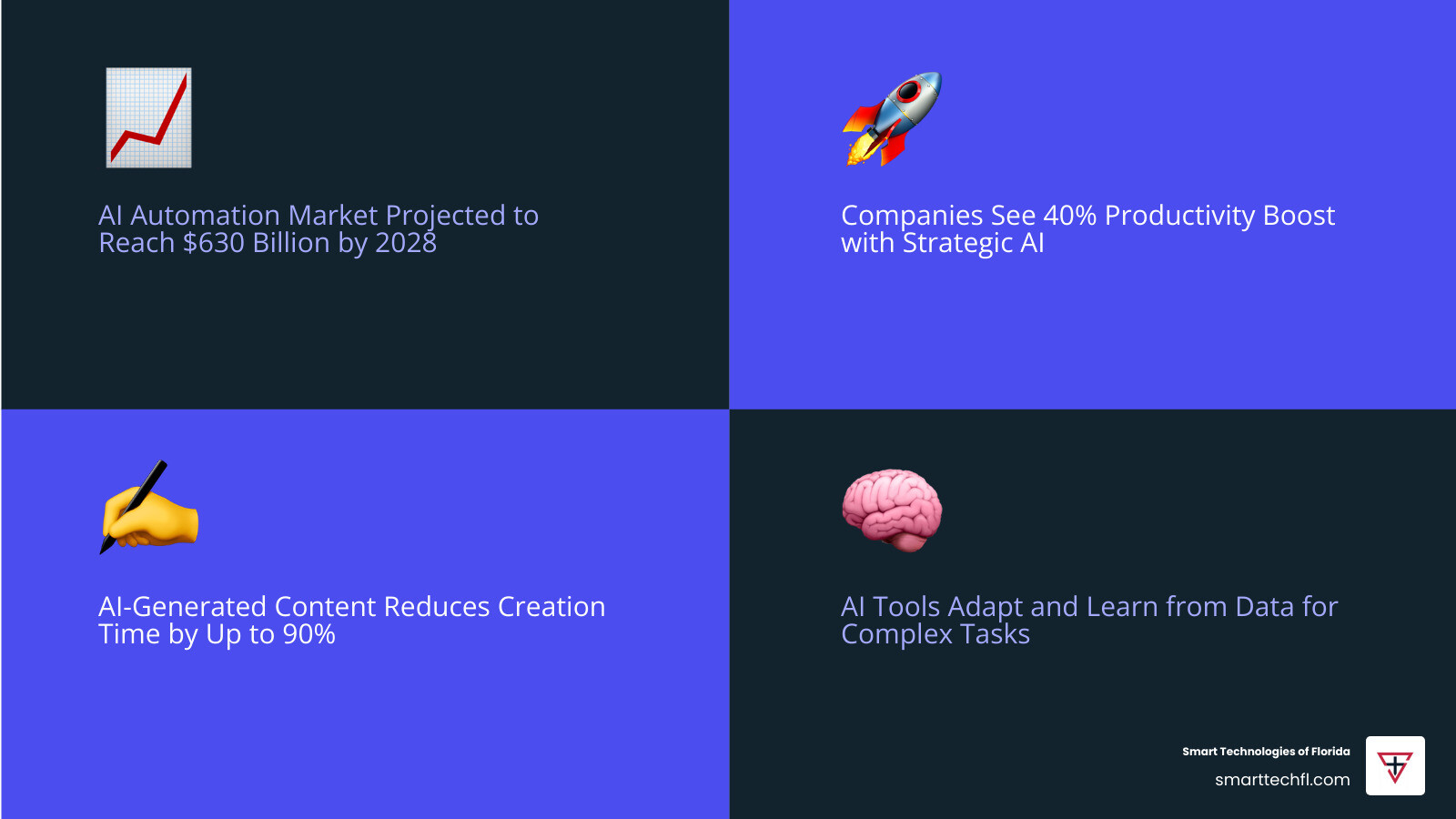AI Automation Tools for Businesses Who’d Rather Work Smarter, Not Harder
AI automation tools are software solutions that use artificial intelligence to handle repetitive tasks, make decisions, and streamline business processes without constant human input. Unlike traditional automation that follows rigid rules, these tools can adapt, learn from data, and handle complex scenarios that change over time.
Here’s what you need to know about AI automation tools:
- What they do: Automate content creation, customer support, data analysis, scheduling, and workflow management
- Key benefits: Save time, reduce costs, improve accuracy, and free up staff for strategic work
- Popular categories: Chatbots, content generators, process automation, scheduling assistants, and data analysis tools
- Getting started: Many offer free tiers or beginner-friendly options like Zapier (100 tasks/month free) and Activepieces (1,000 tasks/month free)
The numbers tell the story clearly. Companies that strategically implement AI-driven automation see a 40% boost in productivity, while AI-generated content can reduce creation time by up to 90%. This isn’t about replacing your team – it’s about giving them superpowers.
Think of it this way: your employees spend countless hours on routine tasks like data entry, email responses, and report generation. AI automation handles these repetitive jobs while your team focuses on strategy, creativity, and building customer relationships.
The market agrees. Spending on AI automation is projected to reach over $630 billion by 2028, as businesses realize these tools aren’t just nice-to-have – they’re essential for staying competitive.

The New Wave of Automation: AI vs. Traditional Tools
Picture this: you’ve set up a traditional automation system that sorts emails. When an email arrives with “invoice” in the subject line, it automatically saves the attachment to your accounting folder. It works perfectly… until someone sends an invoice with the subject line “Payment Due” instead. Suddenly, your system is stumped.
This scenario perfectly captures the difference between old-school automation and the new wave of AI automation tools. Traditional automation follows rigid, rule-based logic – it’s like having a very obedient robot that does exactly what you tell it, but nothing more. You can learn more about rule-based workflows to understand how these systems operate.
AI automation tools are different beasts entirely. They don’t just follow instructions – they actually understand what’s happening around them.
Traditional automation is fantastic for predictable, repetitive tasks that never change. It’s reliable, straightforward, and perfect for simple “if this, then that” scenarios. But here’s the thing: business is rarely that simple.
Real business data comes in messy, unstructured formats. Customer emails don’t follow templates. Social media posts vary wildly. Meeting notes are scattered and informal. This is where AI automation tools shine brilliantly.
The magic happens through adaptive learning. Unlike their traditional counterparts, these tools get smarter over time. They learn from new data, recognize patterns, and handle exceptions just like a human would. When that “Payment Due” email arrives, an AI system can recognize it’s actually an invoice based on the content, not just the subject line.
Natural Language Processing (NLP) gives these tools their superpower to understand human language. This means they can read customer feedback, write marketing copy, or hold natural conversations through chatbots. They’re not just processing data – they’re understanding it.
The cutting edge belongs to AI agents and agentic automation. These intelligent programs can handle complex tasks across multiple applications, making decisions and adapting in real-time. Instead of rigid rules, they work with high-level goals. Tell an AI agent to “manage leads,” and it will figure out the best sequence of actions, adapt when something changes, and keep learning from each interaction.
This represents a fundamental shift from automation that simply executes to automation that truly thinks. While traditional systems handle the predictable stuff, AI automation tools tackle the complex, variable, and intelligent work that used to require human judgment.
The result? Your team gets freed up from routine decision-making to focus on strategy, creativity, and building meaningful relationships with customers.
Key Categories of AI Automation Tools for Every Business Need

The real magic of AI automation tools lies in their incredible versatility. These aren’t just fancy gadgets for tech companies – they’re changing how businesses of every size operate, from your local bakery to Fortune 500 corporations. Every department can benefit from the right AI solution, and the results speak for themselves in terms of business efficiency and operational streamlining. If you’re curious about the broader benefits, check out our insights on Streamlining Business Processes Benefits.
Let’s explore the key areas where AI is making the biggest splash in business operations.
Content Creation & Marketing Automation
Creating quality content used to mean hours of brainstorming, writing, and editing. Not anymore. AI automation tools have completely changed the game for marketing teams, with some companies seeing a 90% reduction in content creation time. That’s not a typo – we’re talking about tasks that took days now getting done in hours.
Content generation tools like Jasper and Rytr can draft everything from blog posts to social media updates in minutes. Rytr alone serves over 8 million happy users and has saved businesses millions of dollars in content creation costs. These tools don’t just spit out generic text either – they can mirror your specific brand voice and tone.
Brand consistency becomes effortless with AI-powered style guides. Your content stays on-brand whether it’s written by your marketing manager or generated by AI at 2 AM. SEO optimization happens automatically too, with AI analyzing search trends and suggesting the perfect keywords to help your content rank higher.
Social media management gets a major upgrade with tools like FeedHive and Buffer handling scheduling and posting across multiple platforms. Pictory takes it further by turning your blog posts into engaging videos for social media. Your audience stays engaged while you focus on strategy instead of posting schedules.
Sales & Customer Support Automation
Your customers don’t sleep, so why should your customer service? AI automation tools in sales and support provide round-the-clock assistance while freeing up human employees for high-value work like building relationships and solving complex problems.
Conversational AI has come a long way from those frustrating chatbots of the past. Today’s AI assistants use natural language processing to understand context and provide genuinely helpful responses. Sintra offers personalized “AI helpers” that learn your company’s specific style over time, making interactions feel more human.
Intelligent ticket routing eliminates the dreaded customer service shuffle. AI analyzes incoming requests and sends them straight to the right department or agent. No more “let me transfer you” conversations that go nowhere.
Lead enrichment happens automatically as AI gathers data on prospects and creates detailed profiles. Tools like Bardeen work as “AI Copilots for GTM teams,” streamlining lead management right in your browser. CRM integration ensures all this valuable data flows seamlessly into your existing systems.
HR & Employee Productivity

HR departments are finding that AI automation tools can transform the employee experience while cutting administrative work dramatically. Nobody enjoys paperwork, and AI is here to handle most of it.
Automated onboarding takes new hires from overwhelmed to productive faster than ever. AI handles welcome kits, paperwork, training schedules, and answers common questions. Tools like Leena AI specialize in automating these routine HR tasks, letting your team focus on making new employees feel welcome.
AI calendar management solves one of modern work’s biggest headaches – scheduling. Tools like Reclaim and Clockwise don’t just find meeting times; they protect focus time and optimize schedules based on how your team actually works. The back-and-forth email chains about meeting times become a thing of the past.
Meeting transcription and summarization through tools like Fireflies and Avoma mean you can actually participate in meetings instead of frantically taking notes. AI captures everything, identifies action items, and creates summaries so nothing falls through the cracks.
Task prioritization gets smarter with AI assistants built into platforms like Asana and Notion AI. These tools learn from your work patterns and suggest optimal workflows based on deadlines and past performance.
IT & Developer Operations
The IT department has always been about efficiency, and AI automation tools are taking that to the next level. From helpdesk operations to software development, AI is handling the routine stuff so your tech team can focus on innovation.
IT Service Management gets a major upgrade with conversational AI that can resolve common issues instantly. Tools like Moveworks and AiseraGPT automate IT requests, with some companies seeing 28% of tickets resolved automatically. Your employees get help faster, and your IT team gets fewer “password reset” interruptions.
Predictive issue resolution means problems get fixed before anyone notices them. AI analyzes system logs and performance data to spot trouble brewing, letting IT teams address issues proactively instead of reactively.
Code generation has revolutionized software development. GitHub Copilot trained on billions of lines of code can suggest entire functions as developers type, dramatically speeding up the development process.
Automated testing through tools like Applitools, Testim, and Functionize uses AI to handle visual validation, identify flaky tests, and even self-heal when applications change. The manual effort in testing drops significantly while quality goes up.
Workflow optimization platforms like Microsoft Power Automate and Make.com connect hundreds of applications (Power Automate works with 350+ apps and services). Make.com serves over 250,000 customers who rely on its powerful automation capabilities to build complex workflows that span multiple systems and make intelligent decisions.
How to Choose and Implement the Right AI Solution
Choosing the right AI automation tools for your business isn’t like picking a new coffee maker. It’s a strategic decision that can transform how your entire team works. After 23 years of helping businesses steer technology changes, we’ve learned that the most successful implementations happen when you focus on people first, technology second.
The good news? You don’t need a computer science degree to make smart choices about AI automation. What you do need is a clear understanding of your business needs and a thoughtful approach to implementation. For more insights on essential automation tools, you can refer to our guide: Automation Tools for Business: 8 Must-Haves.
Key Factors for Selecting your AI automation tools

Think of selecting AI automation tools like choosing a new team member. You want someone who plays well with others, can grow with your company, and won’t create more headaches than they solve.
Integration capabilities should be your first consideration. The best AI tool in the world becomes a expensive paperweight if it can’t talk to your existing systems. Look for solutions that connect easily with your CRM, project management software, and other daily tools. Platforms like Zapier (which has an AI app database of 270 entries) and Make.com have made this much easier by creating bridges between different applications.
Scalability matters more than you might think. Your business today isn’t the same as your business in two years. Choose tools that can handle increased workloads and expanded functionality without requiring a complete overhaul. It’s like buying a car – you want something that fits your current needs but can also handle that family road trip you’re planning.
Ease of use can make or break adoption. Many modern AI automation tools accept a “no-code” or “low-code” philosophy, meaning your marketing manager can set up automations without calling IT. ChatGPT, for example, excels in ease of use (94%) and natural conversation (92%), which explains why it’s become so popular across different departments.
Vendor support and community become crucial when you hit your first roadblock. Excellent customer support, comprehensive documentation, and an active user community can turn a frustrating afternoon into a quick learning opportunity. Think of it as having knowledgeable neighbors who’ve already figured out how to use that new gadget.
Security and compliance isn’t negotiable, especially in today’s data-conscious world. Ensure your chosen tools meet industry standards like SOC 2 for data security and GDPR for data privacy. Your customers trust you with their information – make sure your AI tools respect that trust.
For businesses just starting their AI journey, there are excellent beginner-friendly options with free tiers. Zapier offers 100 tasks per month for free, while Activepieces provides 1,000 tasks monthly at no cost. Microsoft Power Automate also offers a free desktop version, making powerful automation accessible to businesses of all sizes.
A 5-Step Strategy for Successful Implementation
Implementing AI automation tools successfully isn’t about having the fanciest technology – it’s about having the right strategy. We’ve seen too many businesses rush into automation only to end up with frustrated employees and unused software.
Start by defining clear objectives before you even open your wallet. What specific problem are you trying to solve? Do you want to cut customer service response times in half? Automate lead qualification? Eliminate manual invoice processing? Specific goals guide your selection and help you measure success later.
Begin with a pilot project rather than trying to automate everything at once. Pick something small but meaningful – maybe automating appointment confirmations or social media posting. This approach lets you test the waters, learn the system, and build confidence before tackling bigger challenges.
Involve your team from day one because they’re the ones who’ll actually use these tools. The biggest implementation failures happen when technology gets imposed on people rather than introduced to them. Explain how AI automation tools will eliminate their most tedious tasks, freeing them up for the creative and strategic work they actually enjoy.
Provide thorough training and support because even user-friendly tools require some learning. This isn’t just about clicking buttons – help your team understand how their roles might evolve and what new opportunities automation creates for them.
Monitor and iterate continuously because automation rarely works perfectly from day one. Gather feedback from users, track performance metrics, and be ready to make adjustments. Think of it as fine-tuning rather than fixing – you’re optimizing a system that’s already working. We have more detailed insights on streamlining workflow processes here: More on streamlining workflow processes.
Successful AI automation isn’t about replacing human intelligence – it’s about amplifying it. When done right, these tools don’t just save time and money; they create opportunities for your team to do their best work.
Frequently Asked Questions about AI Automation
When businesses first explore AI automation tools, they naturally have questions about how these technologies will actually impact their operations. We’ve helped countless organizations steer this journey over our 23 years in business, and certain questions come up again and again.
Let’s explore the most common concerns and curiosities we hear from business leaders like yourself.
How do AI automation tools improve business decision-making?
The magic of AI automation tools lies in their ability to turn your business data into actionable insights faster and more accurately than ever before. Think about how much information flows through your business every day – customer interactions, sales data, operational metrics, market trends. It’s overwhelming for any human to process effectively.
Data analysis and pattern recognition become superpowers with AI. These tools can analyze massive datasets in minutes, spotting subtle patterns and connections that would take your team weeks to uncover manually. Maybe there’s a correlation between customer service response times and repeat purchases that you never noticed, or seasonal trends in your data that could inform your inventory planning.
Predictive insights take this a step further. AI doesn’t just tell you what happened – it helps you understand what’s likely to happen next. Your sales forecasts become more accurate, you can identify customers who might be thinking about leaving before they actually do, and you can spot potential equipment problems before they cause expensive downtime.
Reduced human error is another huge benefit. When humans manually compile reports or analyze data, mistakes happen. We get tired, distracted, or simply miss things. AI processes information consistently and accurately every time, giving you confidence in your decision-making foundation.
Real-time analytics mean you’re never working with outdated information. Instead of waiting for monthly reports, you get immediate dashboards and alerts that let you respond to changes as they happen. This agility can be the difference between catching an opportunity and missing it entirely.
What is the difference between Robotic Process Automation (RPA) and AI Automation?
This confusion comes up all the time, and it’s completely understandable. Both technologies automate work, but they’re actually quite different in how they operate.
Robotic Process Automation (RPA) is like having a very obedient digital assistant who follows instructions exactly. RPA excels at repetitive, rule-based tasks that never change. It can log into systems, copy data from one place to another, fill out forms, and click buttons – basically mimicking what a human would do on a computer screen. However, if anything changes in the process or interface, RPA gets confused and needs human help to get back on track. You can learn more about RPA here: More on RPA.
AI Automation is fundamentally different because it can think and adapt. These tools understand context, learn from experience, and make intelligent decisions even when faced with new situations. They can read and understand natural language, process images, and handle unstructured data that would completely stump traditional RPA.
Here’s a practical example: RPA might be perfect for automatically moving invoice data from your email to your accounting system, as long as every invoice follows the exact same format. But AI automation tools can read invoices in different formats, from different vendors, and even handwritten ones – then extract the relevant information and make decisions about how to categorize and process each one.
The most powerful approach often combines both technologies. RPA handles the simple, repetitive steps, while AI makes the complex decisions and adaptations needed for complete end-to-end automation.
Can small businesses afford to use AI automation tools?
Absolutely! This might be the biggest myth we encounter – that AI automation tools are only for big corporations with massive budgets. The reality couldn’t be more different.
Scalable pricing models mean you can start small and grow your automation as your business grows. Many platforms offer basic plans that cost less than what you’d spend on office supplies each month. You’re not locked into enterprise-level commitments from day one.
Free and open-source tools provide incredible value without any upfront investment. Zapier offers 100 tasks per month for free, while Activepieces gives you 1,000 tasks monthly at no cost. These generous free tiers let you experiment, learn, and prove the value before spending a dime.
Pay-as-you-go models eliminate the risk of paying for capacity you don’t need. Some platforms charge per task, so you only pay when the automation actually works for you. Activepieces’ cloud plan, for example, charges just $1 per 1,000 tasks – making it incredibly affordable for small businesses.
Focused solutions for specific needs let you target your biggest pain points without buying a comprehensive enterprise system. Maybe you start with an AI writing assistant to help with marketing content, or an automated scheduling tool to eliminate the back-and-forth of appointment booking. Each focused solution can deliver immediate value and clear return on investment.
The productivity gains and cost savings from even basic AI automation often pay for themselves within the first month of use. Small businesses actually have an advantage here – you can implement and see results faster than larger organizations that get bogged down in complex approval processes and legacy systems.
Conclusion: Work Smarter with Strategic Automation
The future of work isn’t about robots taking over – it’s about AI automation tools helping your team become more human. We’ve explored how these intelligent solutions can transform every corner of your business, from marketing and sales to HR and IT operations. The real magic happens when technology handles the routine stuff, freeing your people to do what they do best: think creatively, solve complex problems, and build meaningful relationships.
This isn’t just about keeping up with trends. AI automation tools offer a genuine competitive advantage that can make the difference between thriving and just surviving in today’s fast-moving business world. Companies that accept strategic automation aren’t just working faster – they’re working smarter, making better decisions, and creating more value for their customers.
But here’s what we’ve learned after 23 years in the business: the best technology implementations are the ones that put people first. At Smart Technologies of Florida, we don’t believe in dropping software into your business and walking away. We believe in understanding your unique challenges, empowering your team, and ensuring that every AI automation tool we implement actually makes your people’s work lives better.
Strategic change requires more than just picking the right tools. It needs a partner who understands that behind every workflow, every process, and every automation is a team of real people trying to do their best work. That’s where our people-centric approach makes all the difference.
Your business has incredible potential waiting to be open uped. The question isn’t whether AI automation will change how you work – it’s whether you’ll lead that change or let it happen to you.
Ready to find what’s possible when the right technology meets the right strategy? We’d love to help you explore how AI automation tools can transform your specific business challenges into competitive advantages. Transform your business with our Business Processes Automation services and take the first step toward a smarter, more efficient future.












